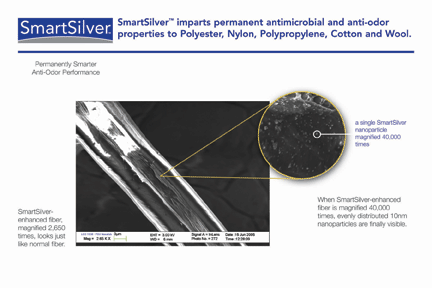Click below for the full story.
Revolution Leaps Beyond Evolution
Bright Future for "Glow-in-the-dark" Fabric
Biomedicine Generates New Life For Textile Maker
with Bill Smith
April 2007
Dealing with the International Marketplace: A Focus on CAFTA
Revolution Leaps Beyond Evolution
Fiber and fabric functionality has evolved over recent decades, with manufacturers offering new “smart fabrics” with improved thermal exchange, stain resistance, wind resistance, durability, hand and more. Generally, the evolution has been deliberate and predictable, with occasional jumps forward, such as we’ve seen with wicking and breathable rain protection.

Nanotechnology has enabled revolution, rather than evolution in industries such as microelectronics and pharmaceuticals. Nanotechnology can bring similar leaps forward to fiber and fabric capabilities. One of today’s most pertinent and significant examples is antimicrobial and odor-fighting fibers and fabrics.
This example is particularly interesting because the last two decades have seen a number of new antimicrobials in textiles. These range from silver-coated wire technologies to silver powders, all of which attempt to leverage silver’s natural antimicrobial properties while attempting to manage silver’s resistance to bonding to anything but itself. Each new approach brought significant trade-offs: performance and durability limits, manufacturing challenges, design constraints, fiber choice restrictions, and last – but not least – cost.
Enter nanotechnology. Through nanoscale engineering – the new ability to customize the tiniest molecules – fabrics that could not previously have permanent anti-odor performance can now acquire effective, permanent antimicrobial and anti-odor properties. Nanoscale engineering enables highly customized molecules to integrate with natural fibers, such as 100% cotton, 100% wool or synthetic fibers, such as polyester. The beauty of nanotechnology is that modifications to fibers are made at such a small scale that they do not affect the hand, stretch, wicking, thermal or other fiber properties. The ideal antimicrobial solution won’t affect the manufacturability, dye-ability, or any other property of the fiber.
For example, in the case of SmartSilver™ (a nanoscale-engineered antimicrobial for textiles), the goal was to create a new material that would impart permanent antimicrobial capabilities to fibers of any type, without affecting any other fiber property, at a reasonable cost using existing fabric manufacturing processes. In this example, scientists leveraged silver’s proven antimicrobial performance and safety, but at nanoscale, creating ultra-tiny molecules that bond permanently to fibers. To the end-user, the only change is the certainty that her sweater, undershirt, socks, gloves, hats, couch or carpet will not smell or attract mold for the life of the item.
The revolution that nanotechnology has enabled in antimicrobial fibers and fabrics is only the beginning. Scientists are working to develop additional nanoscale materials, and we anticipate a future where fibers and fabrics offer a host of nanotechnology-enabled properties: strength without weight, insect resistance, impermeability, memory, durability, and capabilities we cannot yet imagine.
© 1996 Techtextil, Messe Frankfurt Exhibition GmbH